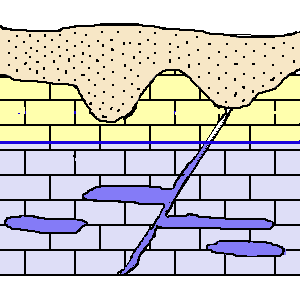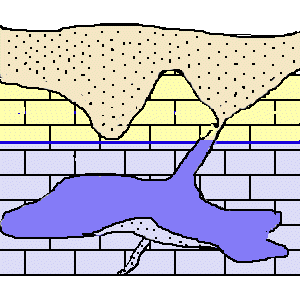| GENERAL How to be a Good Guest Where is Bat Cave? The AREA Area rock Layers Topography Geomorphology Geological History The Paleozoic The Mesozoic The Cenozoic Water The Hydrologic Cycle Solution Solution chemistry Karst Landscapes Erosional Features Depositional Features Environmental Issues BAT CAVE How was Bat Cave formed? Surface Plan of the site Map of the Cave Life in and around Bat Cave A Virtual Trip Through Bat Cave TEST YOUR KNOWLEDGE |
 HOW
AND WHEN WAS BAT CAVE FORMED? HOW
AND WHEN WAS BAT CAVE FORMED? |
 After
the Miocene, when the Hawthorne Formation had been removed by erosion and
the sands had been redeposited on the top of the Limestone, water percolationg
to the limestone began to form cavities and enlarge the joints. After
the Miocene, when the Hawthorne Formation had been removed by erosion and
the sands had been redeposited on the top of the Limestone, water percolationg
to the limestone began to form cavities and enlarge the joints. |
|
 Continued
solution enlarges these voids . Surface solution also begins to create
solution pipes and enlarge the joint patterns. No doubt, some of the surface
materials wash into the drowned cave. Continued
solution enlarges these voids . Surface solution also begins to create
solution pipes and enlarge the joint patterns. No doubt, some of the surface
materials wash into the drowned cave. |
|
 As
the water table drops, the cave is now mostly dry. The water table is still
higher than the lowest portions of the cave most of the time. Those places
form the pools that we see in the cave. By now, surface solution has deepened
the pipes to the point where they breach the roof of the cave, and surface
materials wash into the cave. As
the water table drops, the cave is now mostly dry. The water table is still
higher than the lowest portions of the cave most of the time. Those places
form the pools that we see in the cave. By now, surface solution has deepened
the pipes to the point where they breach the roof of the cave, and surface
materials wash into the cave.
When did this happen? No one knows for sure. Given what we know of the geological history of the area, we can reasonably state that the solution cavities in the limestone were not created before the Hawthorn sands and clays were removed from the area by erosion, a process that began in the Late Miocene. Likely the formation of the cave itself dates back to at least the Pleistocene, but more probably to the Pliocene. The time when the connection between the solution pipes and the cave was established is in greater doubt. In some cases, this appears to have been a fairly recent occurence (geologically speaking). At the base of one of these solution pipes, we have found some remains of a white-tailed deer mixed in with sediments that washed into the cave. These bones have not been completely mineralized, which commonly happens within a few hundreds of years. Unfortunately this only tells us at least how long that particular pipe has been open. It certainly could have been open for a time before that deer fell in or was washed in. Other pipes may be much older, and some do not show an open connection to the cave yet. |